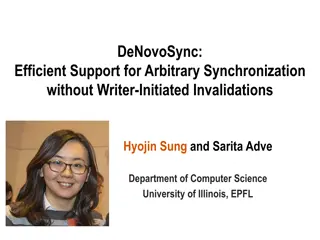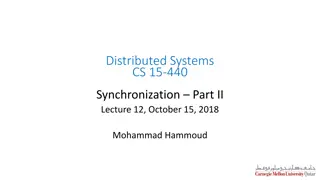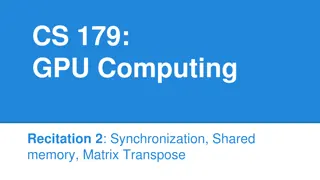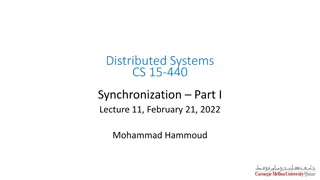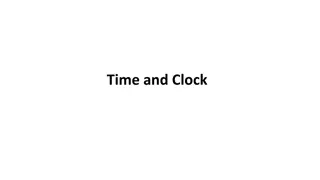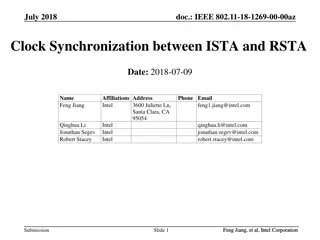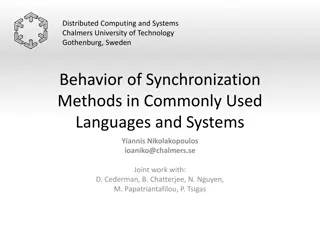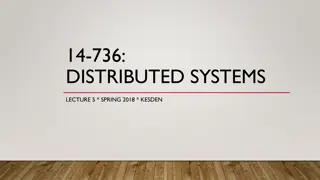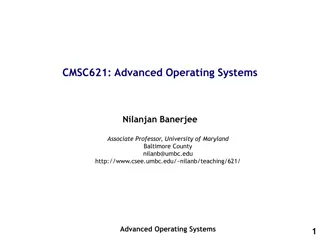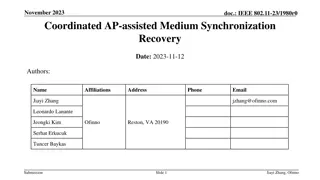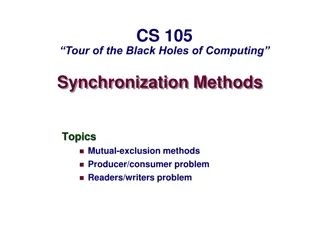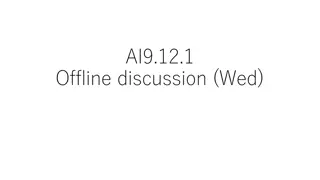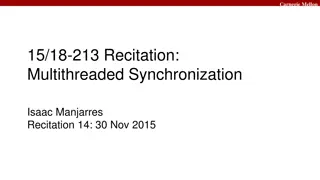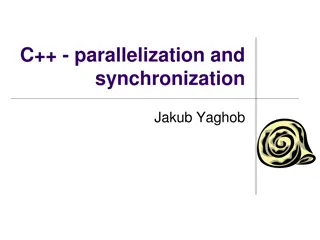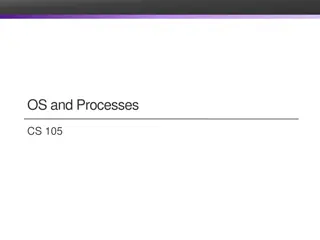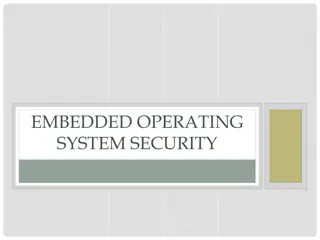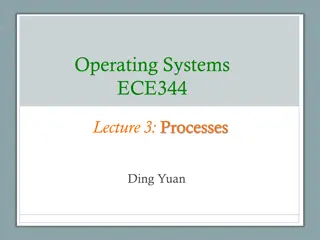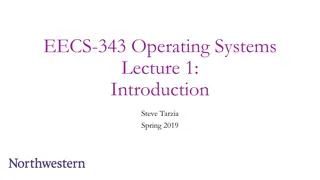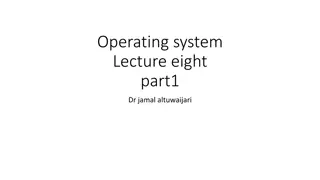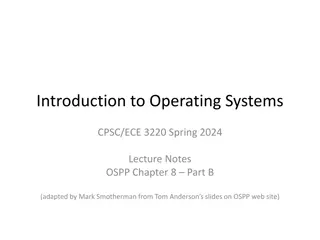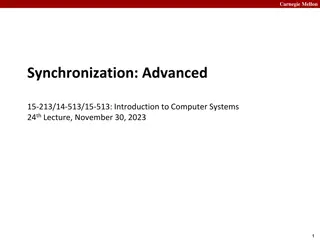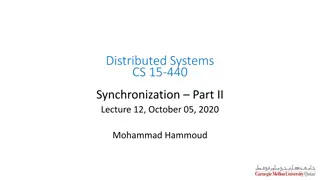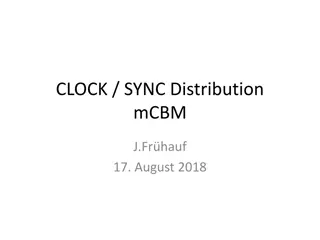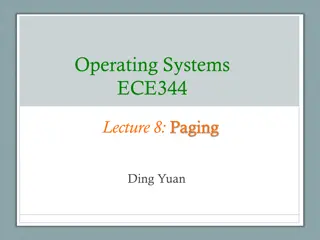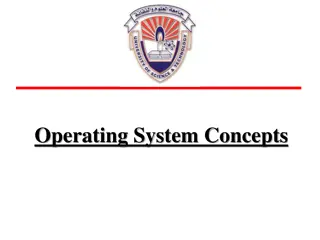Principles of Operating Systems Synchronization Mechanisms
Operating systems utilize high-level synchronization mechanisms such as semaphores, condition variables, and monitors to provide synchronization beyond mutual exclusion. Semaphores are abstract data types that offer mutual exclusion to critical sections, while condition variables model uncounted events and monitors simplify concurrency control policies. These mechanisms help in solving common synchronization problems and ensuring the safety of semaphore values in operating systems.
Download Presentation

Please find below an Image/Link to download the presentation.
The content on the website is provided AS IS for your information and personal use only. It may not be sold, licensed, or shared on other websites without obtaining consent from the author. Download presentation by click this link. If you encounter any issues during the download, it is possible that the publisher has removed the file from their server.
E N D
Presentation Transcript
CSE CSE 120 of Operating Operating Systems Systems 120 Principles Principles of Spring Spring 2016 2016 Using Semaphores and Condition Variables
Higher Higher- -Level Level Synchronization Synchronization We looked at using locks to provide mutual exclusion Locks work, but they have limited semantics Just provide mutual exclusion Instead, we want synchronization mechanisms that Block waiters, leave interrupts enabled in critical sections Provide semantics beyond mutual exclusion Look at three common high-level mechanisms Semaphores: Modelling resource pools Condition Variables: Modelling uncounted events Monitors: Simplifying complex concurrency control policies with mutexes and condition variables Use them to solve common synchronization problems October 13,2015 CSE 120 Lecture 6 Semaphores and Monitors 2
Semaphores Semaphores Semaphores are an abstract data type that provide mutual exclusion to critical sections Described by Dijkstra in THE system in 1968 Semaphores can also be used as atomic counters More later Semaphores are integers that support two operations: Semaphore::Wait(): decrement, block until semaphore isopen Also P(), after the Dutch word for try to reduce (also test,down) Semaphore::Signal: increment, allow another thread toenter Also V() after the Dutch word for increment,up That's it! No other operations not even just reading itsvalue Semaphore safety property: the semaphore value is always greater than or equal to 0 October 13,2015 CSE 120 Lecture 6 Semaphores and Monitors 3
Blocking in Blocking in Semaphores Semaphores Associated with each semaphore is a queue of waiting processes When wait() is called by a thread: If semaphore is open, threadcontinues If semaphore is closed, thread blocks onqueue Then signal() opens the semaphore: If a thread is waiting on the queue, the thread isunblocked If no threads are waiting on the queue, the signalis remembered for the next thread In other words, signal() has history (c.f., condition vars later) This history is acounter October 13,2015 CSE 120 Lecture 6 Semaphores and Monitors 4
Semaphore Semaphore Types Types Semaphores come in two types Mutex semaphore (or binary semaphore) Represents single access to a resource Guarantees mutual exclusion to a criticalsection Counting semaphore (or general semaphore) Represents a resource with many units available, ora resource that allows certain kinds of unsynchronized concurrent access (e.g.,reading) Multiple threads can pass the semaphore Number of threads determined by the semaphore count mutex has count = 1, counting has count =N October 13,2015 CSE 120 Lecture 6 Semaphores and Monitors 5
Using Using Semaphores Semaphores Use is similar to our locks, but semantics are different struct Semaphore { int value; Queue q; } S; withdraw (account, amount) { wait(S); balance = get_balance(account); balance = balance amount; put_balance(account, balance); signal(S); return balance; } wait(S); balance = get_balance(account); balance = balance amount; wait(S); Threads block wait(S); critical section put_balance(account, balance); signal(S); signal(S); signal(S); It is undefined which thread runs after a signal October 13,2015 CSE 120 Lecture 6 Semaphores and Monitors 6
Semaphores Semaphores in in Nachos Nachos P () { // wait Disable interrupts; if (value == 0) { add currentThread to waitQueue; KThread.sleep(); // currentThread } value = value 1; Enable interrupts; } V () { // signal Disable interrupts; thread = get next on waitQueue; thread.ready(); value = value + 1; Enable interrupts; } To reference current thread: KThread.currentThread() KThread.sleep() assumes interrupts aredisabled Note that interrupts are disabled only to enter/leave critical section How can it sleep with interrupts disabled? October 13,2015 CSE 120 Lecture 6 Semaphores and Monitors 7
Interrupts Interrupts Disabled Context Context Switch Switch Disabled During During [KThread::yield] Disable interrupts; currentThread.ready(); runNextThread(); KThread::yield () { Disable interrupts; currentThread.ready(); // add to Q runNextThread(); // context switch Enable interrupts; } [KThread::yield] (Returns from runNextThread) Enable interrupts; Semaphore::P () { // wait Disable interrupts; if (value == 0) { add currentThread to waitQueue; KThread.sleep(); // currentThread } value = value 1; Enable interrupts; } [Semaphore::P] Disable interrupts; if (value == 0) { add currentThread to waitQueue; Kthread.sleep(); [KThread::yield] (Returns from runNextThread) Enable interrupts; October 13,2015 CSE 120 Lecture 6 Semaphores and Monitors 8
Get Operation Get Operation Nope! Nope! We can t add a get() to get the value from a semaphore It could change between when we get() it and when we try to use what we got It can go up via a V() or down via a P() It would necessarily be useless and harmful if used. Students ask, What if a stale value is okay? Just make a call to Random.randInt() instead! Since whatever you could get from the semaphore could get incremented or decremented any number of times before use, a random number within the proper range really, really, really is just as good. October 13,2015 CSE 120 Lecture 6 Semaphores and Monitors 9
Semaphore Semaphore Questions Questions Are there any problems that can be solved with counting semaphores that cannot be solved with mutex semaphores? Does it matter which thread is unblocked by a signal operation? Hint: consider the following three processes sharinga semaphore mutex that is initially 1: while (1) { wait(mutex); // in critical section signal(mutex); } while (1) } wait(mutex); // in critical section signal(mutex); } while (1) { wait(mutex); // in critical section signal(mutex); } October 13,2015 CSE 120 Lecture 6 Semaphores and Monitors 10
Counting vs Binary Semaphores Counting vs Binary Semaphores All semaphores are counting If V()ed they will increment If P()ed they will decrement When semaphores are intended to move between 0 and 1 we call them binary semaphores But, if we break this discipline they will count. There is no safety built-in Binary semaphores can count the availability of a mutually exclusive critical section, i.e. from 1 available to 0 available and vice-versa
Semaphore Semaphore Summary Summary Semaphores can be used to solve any of the traditional synchronization problems However, they have some drawbacks They are essentially shared global variables Can potentially be accessed anywhere in program No connection between the semaphore and the databeing controlled by the semaphore Used both for critical sections (mutual exclusion)and coordination (scheduling) Note that I had to use comments in the code todistinguish No control or guarantee of properusage Sometimes hard to use and prone to bugs Another approach: Use programming languagesupport October 13,2015 CSE 120 Lecture 6 Semaphores and Monitors 12
Condition Condition Variables Variables Condition variables provide a way to wait for events Unlike semaphores, they do not count or otherwise track resources Combined with mutexes, they can be used to manage resource pools. We ll talk about, for example, using them to construct semaphores and higher-level monitors Condition variables are not boolean objects if (condition_variable) then does not makesense if (num_resources == 0) then wait(resources_available) does An example will make this more clear October 13,2015 CSE 120 Lecture 6 Semaphores and Monitors 13
Condition Condition Variables Variables Condition variables support three operations: Wait (Mutex m) add calling thread to the condition variable s queue and put the thread to sleep Signal (Mutex m) remove a thread, if any, from the condition variable s queue and wake it up Broadcast (Mutex m) remove and wake-up all threads in the condition variables queue
Why the mutex? Why the mutex? if (predicate) { --------------context switch--------- cv.wait() } if (predicate) { cv.wait() } The test of the predicate and the wait need to be atomic or two or more threads can end up skipping the wait and entering The critical section Note: cv.wait() must atomically block the calling process and release the mutex or other threads can t acquire it including to signal. It must also require it before returning to put things back as found. mutex_acquire (m) if (predicate) { cv.wait(m) } // possible critical section mutex_release(m) Don t make a habit if the if quite yet. See next slide.
About that ifdont do that! About that if don t do that! if (predicate) { ----------- cv.wait() } while (predicate) { cv.wait() } We ll talk about the reason more shortly. But, the short version is that, we might see a sequence such as (i) a thread wait()s for a condition, (ii) a thread gets dispatched and then pre-empted, (iii) another thread signals and wakes up the wait()ing thread, placing it into the runnable list -- behind the pre-empted thread (iii) before the awoken thread gets to run, the pre-empted thread runs and changes the predicate condition, e.g. consumes some available resources. In this case, a while is needed to ensure the predicate invariant holds. In some cv implementations or uses an if might be safe. But, it is terrible practice. A change in library, software port, or misunderstanding can break things. A while is ALWAYS safe. An if offers no gain just risk. Just make while your habit.
Typical Typical Use Use Mutex mx; GetLock (condition cv, mutex mx){ mutex_acquire (mx); while (LOCKED) wait (cv,mx) ; lock=LOCKED; mutex_release (mx); }
Typical Use Typical Use (cont.) (cont.) ReleaseLock (condition cv, mutex mx) { mutex_acquire (mx); lock = UNLOCKED; signal (cv); mutex_release (mx); }
Using Using Cond Vars & Cond Vars & Locks Locks Alternation of two threads (ping-pong) Each executes the following: Lock lock; Condition cond; Must acquire lock before you can wait (similar to needing interrupts disabled to call Sleep in Nachos) void ping_pong () { acquire(lock); while (1) { printf( ping or pong\n ); signal(cond, lock); wait(cond, lock); } release(lock); } Wait atomically releases lock and blocks until signal() Wait atomically acquires lock before it returns October 13,2015 CSE 120 Lecture 6 Semaphores and Monitors 19
Condition Vars != Condition Vars != Semaphores Semaphores Condition variables != semaphores Although their operations have the same names, they have entirely different semantics (such is life, worse yet to come) However, they each can be used to implement theother Access to the monitor is controlled by a lock wait() blocks the calling thread, and gives up the lock To call wait, the thread has to be in the monitor (hence has lock) Semaphore::wait just blocks the thread on the queue signal() causes a waiting thread to wakeup If there is no waiting thread, the signal is lost Semaphore::signal increases the semaphore count, allowing future entry even if no thread is waiting Condition variables have nohistory October 13,2015 CSE 120 Lecture 6 Semaphores and Monitors 20
Summary Summary Semaphores wait()/signal() implement blocking mutual exclusion Model a resource pool Condition variables Waits for events Does not count Requires a mutex to protect predicate-wait sequence October 13,2015 CSE 120 Lecture 6 Semaphores and Monitors 21


